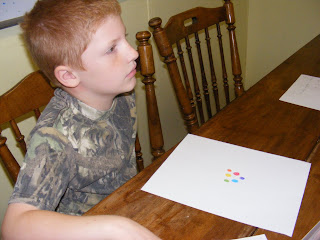Over this summer, I have decided to put a halt on all our unit studies. We all need a break from them! So I decided that, for the summer, we would spend all of our school time focusing on our math. Math is one of those things that really needs to be done, but I kind of let it slide to the wayside during all the hustle and bustle of last year. So we are spending the summer catching up. And I have to say, I am completely amazed at how quickly my kids are progressing! It is amazing what a little age on a kid will do for you. I am convinced that the school books suggest teaching concepts to kids when their little brains just aren't ready to grasp them. But since we put math aside for a big chunk of last year, my kids had time to mature and grow in their thinking and understanding skills, and I have just been blown away at how quickly we are moving through all of this stuff!
A few days ago, I was attempting to teach Britches about prime and composite numbers and factors. For those of you who don't know that (and that would be ME had I not just read the lesson!), prime numbers are numbers that only have 2 factors that can be multiplied together to equal that number. For example, the number 2. The only two numbers you can multiply together to get the number 2 are the numbers 1 and 2 - 1X2=2. Composite numbers are numbers that have more than just two factors that can equal that number. For example, the number 4. The factors for 4 are 1, 2, and 4 - 1X4=4 & 2X2=4. So composite numbers are many numbers that can be used to make the same number.
Anyway, I was teaching this to Britches, and she, of course, picked up on it right away and just went to town with the concept. She understood how it worked, so she easily figured out all the prime numbers and composite numbers. Well, Little Man was across the table doing some art. He is my very kinesthetic learner, which means he learns as he's doing something, touching something, drawing something. He listens better if some part of his body is in motion. So since he was working on his art, I just focused on talking to Britches, but I knew he was listening. Sure enough, before long he put in his two cents worth. He said, "Hey! If prime numbers are the ones that are the #1 best numbers and aren't made up of any other numbers, then the colors blue, yellow, and red must be prime colors! There is math in art!" I looked at him for a second, because, quite honestly, I had to think about that a bit. But as I sat there pondering his statement, it made perfect sense! Those three colors are called the PRIMARY colors! They are the #1 best main colors. You don't mix any colors to make those three, and all other colors come from a combination of those. "YES! You are absolutely right! There IS math in art! Illustrate it for me." So I had him grab his color pencils and show me on his paper the primary colors (prime colors) and the secondary colors (composite colors), and he wrote at the top of his page what they were. That page got filed in his math binder with his other worksheets.And Britches decided to pull out her paints and do the same thing, starting with prime colors and mixing them into composite colors.
The greatest thing to me, though, is the fact that Little Man made the connection! He understood the concept and could readily relate it to something he was interested in. Once he understood that, he went to work figuring out all the prime numbers, too. And by presenting it the way I did, and him relating it to his art, it took all of about 5 minutes to teach that lesson. WOOHOO! On to the next thing...



I LOVE those moments! What a smartie pants that boy is! :)
ReplyDelete